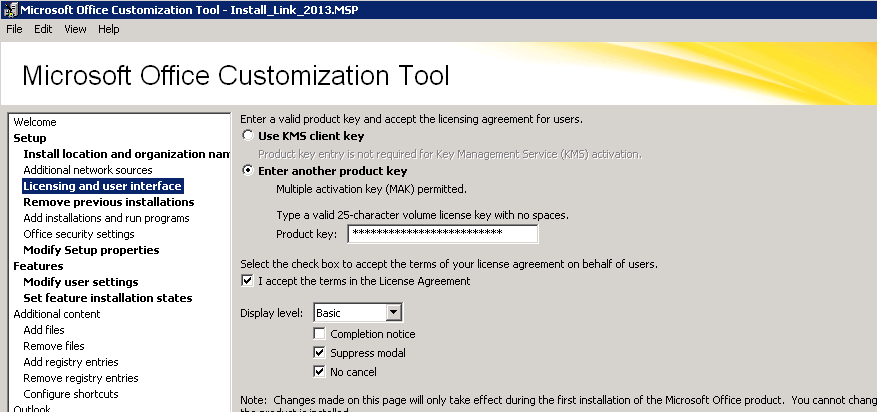This post will explain Step by Step instruction How to DEPLOYING and UPGRADING OFFICE 2013 WITH SCCM 2007 with Zero Touch
Uninstall Office 2010
Create “SilentUninstallConfig.xml” and past in “ProPlus.WW” Folder 
Create SilentUninstallConfig.xml using the below code
<Configuration Product="ProPlus">
<Display Level="basic" CompletionNotice="no" SuppressModal="yes" AcceptEula="yes" />
<Setting Id="Reboot" Value="Never" />
<Setting Id="SETUP_REBOOT" Value="Never" />
</Configuration>
Create Uninstall CMD using the below command
"%~dps0setup.exe" /uninstall ProPlus /config .\ProPlus.WW\SilentUninstallConfig.xml
Place the Uninstall CMD in the Office setup.exe folder
Create Uninstall VBS to uninstall the Visio 2010 without restart in the end of the uninstallation
Uninstall.vbs
Dim Retval
Retval=0
' *** Install Application. ***
Dim WSHShell
Set WSHShell = WScript.CreateObject("WScript.Shell")
' open normal and don't wait
WSHShell.Run "Uninstall.cmd", 1, True
Set WSHShell = Nothing
' *** show us what RETVAL is, unrem to see what retval = ***
'MsgBox "The actual return code was " &retval
' *** unrem to set to 3010 for testing ***
'retval = 3010
If retval = 3010 Then
MsgBox "The return code was 3010, resetting to 0"
else
'MsgBox "The actual return code was " &retval
WScript.Quit(Retval)
End If
' *** set the return value to 0 anyway. ***
Retval=0
MsgBox "The return code was reset to 0"
WScript.Quit(Retval)
Run the Uninstall.vbs in SCCM program.
Installing Office 2013
Process Steps
-
Start the Office Customization Tool (OCT), by running Setup.exe /admin, from the source folder. (The OCT is available only with the volume license editions of Office)
-
If required click OK to the User Account Control (UAC) prompt.
Verify that the correct product and version is selected, and click OK.
-
In the Default File Types, pop-up, select the format you wish to use. The default is “Keep Current Settings”. In this example, I’ll select Office Open XML formats, and then Click OK
-
In the Microsoft Office Customization Tool wizard, you can customize almost all available settings, but in this example, I’ll only configure a few of these settings, to make the installation unattended, and to provide a simple user experience to users, when they install Office 2013 from the System Center 2012 Application Catalog.
Select Install location and organization name, and fill-in your company name.
Select Licensing and user interface, and select “I accept the terms in the License Agreement”. In the Display level, select Basic, and select both Suppress modal, and No cancel.
Note: If you do not plan to use KMS or Active Directory-Based activation, you should also specify the MAK product key on this page

OR
Select Modify Setup properties, and click Add…
In the Add/Modify Property Value dialog box add the following information, and click OK:
Name: SETUP_REBOOT : Value: Never Name: AUTO_ACTIVATE : Value:


To disable the Office 2013 Welcome screen, select Modify user settings, expand Microsoft Office 2013, Privacy and Trust Center. Select Disable Opt-In Wizard on first, and double click on the setting and select Enable.
Set Feature for Office 2013 as per your requirement.
That’s it… Click File and then Save, and then save the MSP file in the Updates folder in the source folder.
The source folder is now prepared for unattended installation, and if you run setup.exe, from the source folder, the installation should be 100% silent.
Create Install VBS to Install the Office 2013 without restart in the end of the installation
Install.vbs
Dim Retval
Retval=0
' *** Install Application. ***
Dim WSHShell
Set WSHShell = WScript.CreateObject("WScript.Shell")
' open normal and don't wait
WSHShell.Run "Setup.exe", 1, True
Set WSHShell = Nothing
' *** show us what RETVAL is, unrem to see what retval = ***
'MsgBox "The actual return code was " &retval
' *** unrem to set to 3010 for testing ***
'retval = 3010
If retval = 3010 Then
MsgBox "The return code was 3010, resetting to 0"
else
'MsgBox "The actual return code was " &retval
WScript.Quit(Retval)
End If
' *** set the return value to 0 anyway. ***
Retval=0
MsgBox "The return code was reset to 0"
WScript.Quit(Retval)
Run the install.vbs in SCCM program.
Uninstall Program:
Create “SilentUninstallConfig.xml” and past in “ProPlus.WW” Folder 
Create SilentUninstallConfig.xml using the below code
<Configuration Product="ProPlus">
<Display Level="basic" CompletionNotice="no" SuppressModal="yes" AcceptEula="yes" />
<Setting Id="SETUP_REBOOT" Value="Never" />
</Configuration>
Create Uninstall CMD using the below command
"%~dps0setup.exe" /uninstall ProPlus /config .\ProPlus.WW\SilentUninstallConfig.xml
Place the Uninstall CMD in the Office setup.exe folder
Create Uninstall VBS to uninstall the Office 2013 without restart in the end of the uninstallation
Uninstall.vbs
Dim Retval
Retval=0
' *** Install Application. ***
Dim WSHShell
Set WSHShell = WScript.CreateObject("WScript.Shell")
' open normal and don't wait
WSHShell.Run "Uninstall.cmd", 1, True
Set WSHShell = Nothing
' *** show us what RETVAL is, unrem to see what retval = ***
'MsgBox "The actual return code was " &retval
' *** unrem to set to 3010 for testing ***
'retval = 3010
If retval = 3010 Then
MsgBox "The return code was 3010, resetting to 0"
else
'MsgBox "The actual return code was " &retval
WScript.Quit(Retval)
End If
' *** set the return value to 0 anyway. ***
Retval=0
MsgBox "The return code was reset to 0"
WScript.Quit(Retval)
Run the Uninstall.vbs in SCCM program.
Office 2010 form 2013
Place a task sequence as below:
This will be 100% error free Upgrade form Office 2010 for Office 2013.
Source & Credit:
http://www.ronnipedersen.com/2012/11/how-to-deploying-microsoft-office-2013-using-configmgr-2012/
